Magical and Practical Valuation of Stocks: What You Should Know.
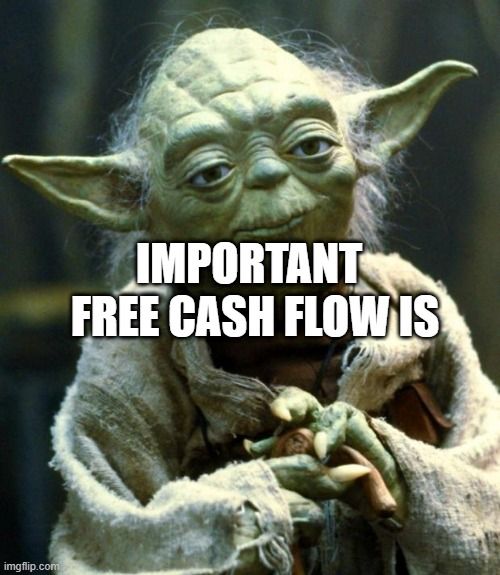
How (not) to quickly value a company.
When I first started investing, I was amazed by the number of tools available to estimate a company's "fair value", to then become overwhelmed by the highly different results they gave me for the same stock.
Let's run through a quick example on January 31st: is Zebra Technologies (ZBRA) reasonably valued? I love this stock as it is a pick and shovel play for the future of supply chain management, but it grew 509% in the past 5 years, outperforming 5x the S&P500, so is it too expensive now?
- According to the GuruFocus Fair Value model, it is more than 55% overvalued.
- According to SimplyWall.st, their discounted cash flow model results in a 15% overvaluation and falls into their margin of error for "Fairly Valued".
- According to Finbox Fair value model, it is fairly valued within a 5% error margin.
- According to the average Analyst, its 12-month price target is 19% above its current price, which would make it roughly fairly valued.
Confusing right? Some of these tools are transparent about their model; some are not. Some use average fair value between multiple valuation models; some use the result of one model. Some use models based on the historical valuation (multiples) of the stock, some on relative valuations compared with peers, and some use forecasted value creation performance to put a price.
I decided to learn the basics of valuation and went for the textbook bible: The Valuation Book by Mckinsey, a 500 pages monster that would make you want to read War & Peace from Tolstoi instead.
Here is the summary: done by a rookie for rookies. It made things easier for me when trying to value a company. But it also made me understand that serious deep valuation requires a lot of manual research and time, which most of us do not have. So I will share with you some quick tips on applying valuation fundamentals in a more scalable way, which is better than relying on a third-party tool one does not understand, but worse than doing deep research with a customized valuation process.
The fundamentals of value creation
Alfred Marshall's definition is still widely accepted as the best one: companies that grow and earn a return on capital (ROIC) that exceeds their cost of capital create value. So value creation comes as a mix of growth and returns.
Creating value does not mean maximizing today's share price, but instead maximizing the value created to all its shareholders, both now and in the future.
The only thing that drives value is cash flow, not earnings (nor P/E).
Growth and good returns on invested capital precede good earnings, but the contrary is not necessarily true.
For example, buying back shares increases earnings per share (EPS), but it does not create value. Why not? "Because the total cash flow of the business has not increased. While EPS has increased by 5 percent, the company's debt has increased as well. With higher leverage, the company's equity cash flows will be more volatile, and investors will demand a higher return. This will bring down the company's P/E, offsetting the increase in EPS." 🤯Boom, this is why Price to Free Cash Flow is often considered superior to price to earnings when assessing intrinsic value.
Another example that earnings are not a reliable indicator of value creation is margin improvements. One kind of "improvement" comes purely from cost-cutting and may be value destructive, such as when investments in research or marketing are cut back to improve short time earnings.
Cash flows rather than accounting earnings will inevitably justify share prices. According to the book's authors, there appears to be no correlation between EPS variability and a company's market value.
The value of a business is the present value of the expected cash flows in the future. "Free Cash Flow" is an accounting metric which measures "what's leftover for investors once investments have been discounted". So yes, the preferred method for valuing a company should be the infamous "Discounted Cash Flow" (DCF) method. The debate starts when you start estimating where these cash flows will come from.
By the way, maximizing Free Cash Flow cannot be accomplished in the long run without maximizing value to customers, employees and the community in general. This is why "long term" capitalism is positive capitalism, and if you do want to have a positive impact, even a little bit, day trading is the opposite. Long-term investing is both good for you and the planet.
An organization's ROIC and free cash flow (FCF) are integral to its valuation, but they cannot easily be computed from its financial statements and require extra manual work. The textbook definition of the Free Cash Flow as a value creation metric implies the Free Cash Flow and ROIC calculated by popular websites such as GuruFocus, StockRow, Finbox, TIKR and any other are different from the Book's definition.
Is Value creation the same as Shareholders' return on investment?
The impact of market expectations on share prices
"The return that investors earn is driven not by the performance of our company, but by its performance relative to expectations."
A total shareholder return (TSR) based on shorter periods of time may not accurately reflect a company's performance, since TSR is heavily influenced by the company's performance and investors' expectations.
Good companies may not make good investments in the short run because they may already be priced for excellent future performance.
However, TSR and value creation do converge over the long term.
The dramatic swings in share prices sometimes prompt finance professionals to conclude that established valuation theories are irrelevant and that stock markets have a life of their own independent of economic growth and profitability.
But the book's authors do not agree. According to their analysis, valuation levels reflect the underlying fundamental performance in terms of return on capital and growth as a whole and for individual companies. Occasionally, valuations deviate from fundamentals, but these tend not to last long.
In the long term, the facts show that individual stocks and the market as a whole track return on invested capital (ROIC) and growth.
Here is an extract of the book that concretely explains why this convergence happens. "Say trading starts when the price of a single share in the market is $30. Informed investors start buying shares because they believe the shares should be worth $40 to $60; such buying drives up the share price. Some noise traders notice the rising share price and begin to purchase as well. This accelerates the share price increase, attracting more and more noise traders. As the share price increases, the informed investors gradually slow their purchases. At $44, the most pessimistic begin to sell. Once the price passes $66, all informed investors are selling. Momentum declines, which some of the noise traders sense, so they also begin to sell. The selling pressure builds, and the stock price begins to fall. The noise investors accelerate the fall, but this slows as more and more informed investors begin to buy until, at $36, all informed investors are buying again, and the fall is reversed."
the U.S. stock market has been fairly priced and has generally oscillated around its fundamental P/Es. They conducted a similar analysis of the European stock markets and obtained similar results.
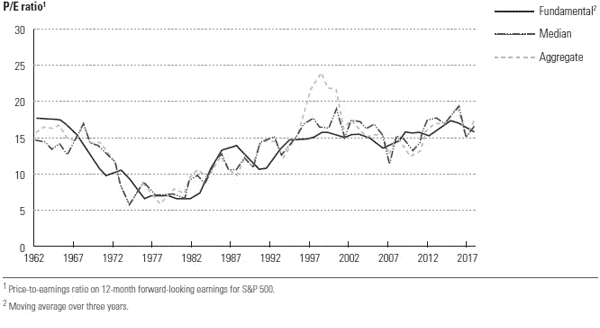
How to calculate Free Cash Flow and ROIC
To calculate ROIC and FCF, the accounting financial statements must first be reorganized into new ones that distinguish between operating items, non-operating items, and funding sources.
Free Cash Flow (FCF)
Free cash flow is distinct from the "cash flow from operations" reported in a company's annual report. It is separate from financing flows and nonoperating items. Free cash flow statement starts with NOPAT (instead of net income like 99% of the websites that calculate it for you). The net income is the profit available to equity holders only, whereas NOPAT is the profit available to all investors, including debt and equity providers. In other words, NOPAT is the operating income discounted from tax.
Once you have the NOPAT, you then add back the accounting stuff that did not represent a real cash outflow: depreciation and change in working capital. After which, you subtract the capital invested (CapEx) as it was a real cash outflow. So FCF = Operating Income * (1-tax) + depreciation + change in working capital - CAPEX.
Usually, websites that calculate Free Cash Flow for you also add back employees' stock-based compensation to the Net Income, which most valuation experts believe is a mistake. That can explain significant differences between your manual calculation of FCF vs. the one calculated by these websites.
Return on invested capital (ROIC)
Return on invested capital equals after-tax operating profits (NOPAT) divided by the capital invested in working capital and property, plant, and equipment. So ROIC = Operating Income * (1-tax) / capex
This is why a company can increase ROIC by either improving profit margins or improving capital productivity.
Free Cash Flow Growth: the one metric to summarize value creation
Value creation depends on both ROIC and growth. ROIC allows calculating the rate at which FCF can grow in the future. So FCF growth is the one metric that can access the value creation mix of growth and returns.
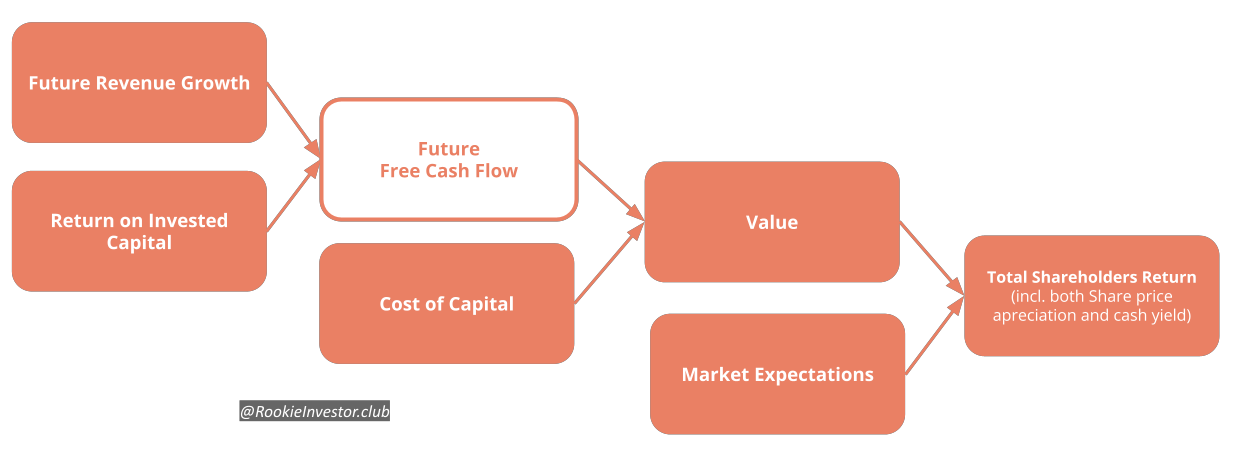
Given the fact that FCF, albeit calculated a bit differently, is widely available and you can calculate its growth even when negative, I find most easy to look and compare FCF growth as a quick measure of value creation assess rapidly if the market expectation of a company is whether in fantasyland or not.
Unprofitable and high growing businesses
Young and fast-growing companies are harder to value because most have negative ROIC and Free Cash Flows. They invest so much to become leaders in their respective nascent industries that growth is prioritized over returns during the first years. With scale comes operating leverage, if the business has the correct value drivers (see next section), which means future positive returns. So evaluating value drivers is where you should spend most of your time valuating a high-growth, still unprofitable, business.
It means you have to do the work of forecasting future revenues, margins and financing costs to know how much FCF and ROIC the business will generate and when, then value it at present value with a discounted cash flow model (DCF). Of course, these forecasts have a high positive and negative risk, so the authors recommend building different scenarios and probability attached to them, then caclucate the weighted average of each scenario result. This is why it is almost impossible to "automate" the valuation of this kind of company.
The value creation drivers
Growths strategies are not created equals.
It's not just revenue growth that matters for creating value; it's the value created per dollar of additional revenue. This guiding principle of value creation links directly to competitive advantage, the core concept of business strategy.
In general, competitors' ability to respond to a company's growth strategy determines its effectiveness. Competition tends to erode competitive advantages and, with them, returns on invested capital.
True product innovation offers the most potential for growth in this regard, since entire new product categories are created.
Empirical studies show that over the past five decades, companies have been generally successful in sustaining their rates of ROIC. It appears that when companies have found a strategy that creates competitive advantages, they are often able to maintain and renew these advantages over many years.
Amazon, Google, Microsoft, and others have retained and renewed their competitive advantages for two decades and more.
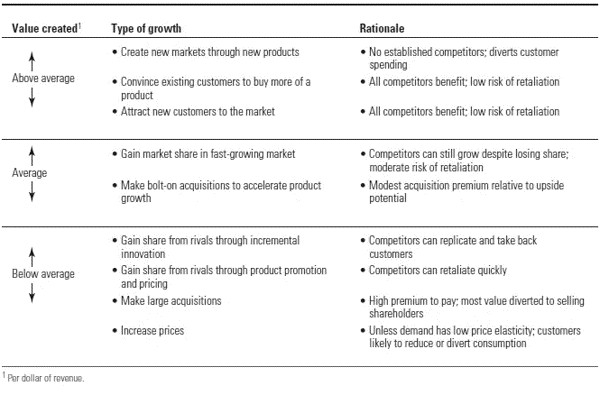
Pricing power
To earn a higher ROIC, a company needs a competitive advantage that enables it to charge a price premium or produce its products more efficiently (at lower cost, lower capital per unit, or both).
On balance, price premiums offer any business the most significant scope for achieving an attractive ROIC, but they are usually more challenging to accomplish than cost efficiencies. This pricing power is usually dependent on other value drivers such as intangibles, network effects or switching costs.
For example price premiums based on brand are sometimes hard to distinguish from price premiums based on quality, and the two are highly correlated (as in the example of BMW. Quality means an actual or perceived difference between one product or service, and other consumers are willing to pay a higher price.
Switching Costs
When replacing one company's product or service with another's is relatively costly (relative to the product's price) for customers, the incumbent company can charge a price premium.
Gillette's shaving products offer a classic example: the manufacturer realizes its margin not on the starter pack but on replacement razor blades.
Sonos also create a form of lock-in: once customers have one or more loudspeakers installed, they are not likely to switch to other brands when replacing or adding units, as these would lack compatibility with their existing Sonos units.
High switching costs, relative to the price of the product or service, create the strongest customer lock-in. Medical devices, such as artificial joints, can lock in the doctors who purchase them, because doctors need time to train and become proficient in the device use.
Barriers to entry and competition intensity
Rational, legitimate pricing discipline typically works when one competitor acts as the leader and others quickly replicate its price moves. In addition, there must be barriers to new entrants, and each competitor must be large enough that a price war will indeed reduce the profit on its existing volume by more than any extra profit gained from new sales. If smaller competitors have more to gain from extra volume than they would lose from lower prices, then price discipline will be tough to maintain.
Cost advantage
Cost efficiency is the ability to deliver products and services at a lower cost than the competition. It is usually linked to Capital efficiency, which is about delivering more products per dollar of invested capital than competitors.
Intangibles
These include brand, quality, patents, innovative business methods and innovation capacity.
A company's business method combines its production, logistics, and pattern of interaction with customers. Most production methods can be copied, but some are difficult to reproduce at some times. Good design can be challenging to replicate. An example of an innovative product line that is not patent-protected but still difficult to copy was Apple's series of iPod MP3 players.
Innovation is one of the most vital intangible assets. Whether a company can sustain a given level of ROIC depends on the length of the life cycles of its businesses and products, the length of time its competitive advantages can persist, and its potential for renewing companies and products. Few companies or products have life cycles as long as Coca-Cola's. Most companies need to find renewal businesses and products to leverage existing advantages or build new ones.
Network effects
Some scalable businesses models provide extraordinarily high returns on capital because they exhibit network economies that increase returns to scale. As the business gains customers and grows, the cost of offering the products decreases, and their value to customers increases. Such scale leads to superior lasting returns only if a company can prevent competitors from achieving similar scale.
Integrating these concepts for a Rookie Investor
If you are a rookie investor like me, you probably want to know a "quick way" to apply all these concepts at scale without spending too much time on it.
Automating value drivers evaluation
I built the Rookie scorecard with precisely this in mind. After using it for the past 2 years, my conclusion is that it is constructive for flagging excellent businesses, or potential problems. Unfortunately, it is not enough to replace the manual work of understanding a company´s value and choose whether to invest in it. This is why I only automated about half of the scoring, the other half is made manually by trying to understand the story behind the numbers.
Automating valuation
Automating valuation has the same issues. It helps flag both positive and negative outliers, but should not be taken as the holy truth without doing your manual homework. I automated it by bulk importing the Free Cash Flow forecast for the next 5 years made by analysts (from Finbox), then comparing it to how much it would need to grow FCF to justify its current price to Free Cash Flow (the equivalent of P/E ratio but with FCF instead of earnings). It enables for this kind of visualization.
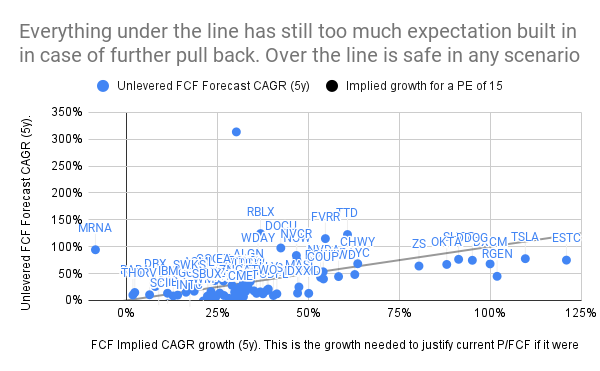
How to calculate the implied Free Cash Flow growth? I do it with this formula. It assumes a discount rate (or cost of capital) of 10%, which is more conservative than any industry average. It also assumes that the Price to Free Cash Flow will be back at the market average of 15 five years from now. This is too conservative for many companies, but as I said, it is more about flagging outliers than trying to be exact. I also compare the past FCF growth rate with the implied one. As you probably noticed, this method is useless for you companies without positive free cash flow.
A simple valuation tool to compare value creation with market expectation
I built a "valuation rank", which gives 1 point to companies with an implied growth equal or less than the analyst forecast, and -1 point if this implied growth is 10 percentage points higher than the actual forecast. I also add half a point if the past average growth is 5 pp higher than the implied growth, and subtract half a point if it is 100 pp lower than the implied growth. These ranges give me a kind of "safety margin". Every company with a forecast and cash flow positive can fare anything between -1.5 and +1.5. I published this experimental score for my watchlist here. About 40% of the tracked tickers have a positive rating, only 13% have the maximum score, while 31% have the minimum score. Guess what? Zebra Tech (ZBRA) has the maximum score.